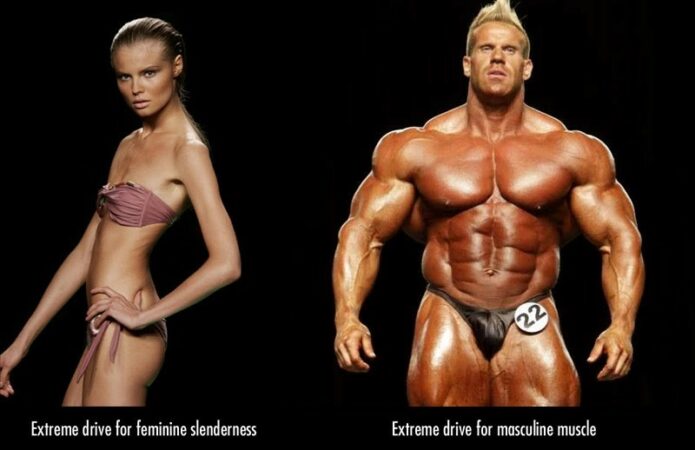It’s not only women who struggle with disordered eating and other mental health conditions
While often overlooked, men also struggle with forming a healthy relationship with food and their body. Research demonstrates that 25% of individuals diagnosed with eating disorders are men (12), and often men suffer in silence due to the stigmas surrounding men and mental health. For these reasons, men who suffer with eating disorders and other mental health problems are often left undiagnosed for long periods of time, due to the misconception that an eating disorder is a “women’s disease”, leading to an increased severity of their condition (13). Similarly, it takes longer for men to seek out professional help when they are experiencing a mental health problem, which may lead to their condition being prolonged (14).
Many men face pressures to be strong and unaffected by mental health or body image struggles, but in reality, this is not realistic. Men too are individuals with feelings and concerns, and those concerns need to be taken seriously and addressed. Society’s standards of how a man must always be strong, dominant, and emotionless are outdated and must be changed. More recently, there have been multiple male athletes who have opened up about their personal struggles with mental health. Olympic swimmer, Michael Phelps, has been open about struggling with depression, and claims that once he finally opened up and shared what he was feeling, he felt a huge sense of relief. In a 2016 interview with ESPN, Phelps describes how no amount of Olympic Gold medals made him feel better, and it wasn’t until he started to seek professional help, that he began to recover (15).
It is important for men to understand that struggling is a normal part of life, and asking for help is a good thing, as it is a sign of strength and drive for better health.
Eating disorders look different in men than they do in women
The primary difference between males struggling with eating disorders and females struggling with eating disorders is eating disorder motivation. While women tend to focus on becoming thin, men tend to become fixated on becoming as muscular and/or lean as they can, a concept referred to drive for muscularity or drive for leanness. It has been reported that up to 90% of adolescent boys wanted to become more muscular and would workout with the goal of increasing their muscle mass (17).
When it comes to treatment of eating disorders, men are much less likely to seek professional help, but need it just as much as women. It is estimated that in the United Stated, 10 million men will be affected by eating disorders at some point in their lives, and male athletes are at an increased risk for disordered eating behaviors and clinical eating disorders (16). It is important for practitioners and therapists to understand the differences in treating men and women with eating disorders. Men will often feel uncomfortable going to therapy or seeking guidance for their eating disorder or other mental health problems and must be encouraged for taking steps to get help.
Men’s drive for muscularity is linked to body dysmorphia
Eating disorders in men may look different than in women because men have different standards and goals when it comes to body image. In women, the societal standard is to be thin, however, in men, it is to be muscular and lean (7). This drive for muscularity can be linked to body dysmorphia and eating disorders. Body dysmorphia is a mental health disorder in which individuals intensely think about the appearance of their bodies and may see themselves as something they aren’t when they look in the mirror. Because body dysmorphia involves an obsessive focus on a perceived flaw in appearance, signs and symptoms of body dysmorphia include a preoccupation with appearance, regularly comparing yourself to others, believing that your body has a defect in appearance, and engaging in behaviors to change or hide a perceived flaw with your body (6). Men with this disorder may frequently examine their appearance in a mirror, constantly compare their appearance with that of others, and may avoid social situations or photos (6). All men are susceptible to feeling this pressure from society to be muscular and lean which makes them susceptible to developing an eating disorder as well.

Causes of eating disorders in men
Eating disorders may develop overtime due to various reasons such as societal, coaching, parental, or personal pressure to look a certain way. It is likely that men with eating disorders develop body dysmorphia which is a mental disorder in which they may see themselves as something they aren’t when they look in the mirror (6). In men, it is common for them to want to gain lean muscle mass to become what society has set to be the “expected” body type of a male which is strong and lean. This standard alone may lead to disordered eating or eating disorders and adding more pressure from coaches or parents will only drag them further into disordered eating. Other factors that may lead to an eating disorder include depression, anxiety or feeling an overall loss of control in one’s life (9). Men suffering with poor mental health are more susceptible to developing an eating disorder because often times, depression or anxiety coincide with a loss in appetite which can lead to a low energy availability due to under fueling. Once this cycle has started, symptoms of depression may continue to get worse due to the added fatigue of under fueling which can lead to a worsening eating disorder (9).

Warning signs of an eating disorder in men
Eating disorders in men are less prominent, which is why they can go unnoticed very easily. Some warning signs to look out for in men are over exercising, eating very little or may avoid eating around others, increased focus on weight or body shape and recurrent stress fractures/overuse injuries. (1) Another warning sign of an eating disorder is poor mental health, which may look different in men. When men are struggling with depression, it is common for them to express anger, irritation and aggression and it’s not as common for them to express sadness which is a common sign in women when suffering from depression (2). However, this doesn’t mean that some men will not express sadness when depressed (2).

Personal story from a male athlete who has struggled with mental health and an eating disorder
Men are typically expected to be emotionless and tough which can be problematic for some men when trying to reach this socially accepted standard. Men are sometimes taught to keep their emotions to themselves and many feel weak if they do express their feelings or emotions. A true personal story about a male collegiate athlete explains how these feelings have affected his mental health. This athlete, [for the sake of anonymity we will refer to as ‘John’] talked about how growing up, he was taught that men were not supposed to cry and how he has struggled with this expectation. Not only was John not expected to show emotions, but he was also supposed to look a certain way for his sport. John explained how he has always had a small and slim stature and how his coaches wanted him to be more muscular. As John got older, these expectations started to affect him in ways he didn’t expect. He became depressed and started to control what he would eat in hopes of getting a more muscular stature that was wanted by his coaches. John developed some very unhealthy eating habits and it got to a point that he had to reach out for help. After getting the help he needed, John came to the conclusion that he didn’t have to live up to other people’s expectations of himself, showing great improvement in his self-concept. John was grateful to switch his thought process surrounding his own mental health, and gaining the skill to improve his self-concept helped him feel more confident in himself and he was able to enjoy life and training more than ever before.
John’s story is only one of many and society needs to be aware of the social pressures that can be placed on men in the future.
- Diving
- Gymnastics
- Ice Skating
- Dance
- Wrestling
- Boxing
- Rowing
- Running
- Ski Jumping
- High Jump
- Pole Vault
- Cycling
References
1. “Young Men’s Health.” Young Men’s Health, 31 Jan. 2019, youngmenshealthsite.org/.
2. “Mental Health: Effects on Men and Women.” MindWise, 19 Feb. 2019, www.mindwise.org/blog/uncategorized/mental-health-effects-on-men-and-women/.
3. A;, Baum. “Eating Disorders in the Male Athlete.” Sports Medicine (Auckland, N.Z.), U.S. National Library of Medicine, pubmed.ncbi.nlm.nih.gov/16445307/.
4. A;, Baum. “Eating Disorders in the Male Athlete.” Sports Medicine (Auckland, N.Z.), U.S. National Library of Medicine, pubmed.ncbi.nlm.nih.gov/16445307/.
5. Pritchard, Mary, and Brooke Cramblitt. “Media Influence on Drive for Thinness and Drive for Muscularity.” Sex Roles, Springer US, 2 Aug. 2014, link.springer.com/article/10.1007%2Fs11199-014-0397-1.
6. “Body Dysmorphic Disorder.” Mayo Clinic, Mayo Foundation for Medical Education and Research, 29 Oct. 2019
7. Leone, James E, et al. “Recognition and Treatment of Muscle Dysmorphia and Related Body Image Disorders.” Journal of Athletic Training, National Athletic Trainers Association, 2005,
8. Posted under Health Guides. Updated 12 February 2021. +Related Content. “Eating Disorders: Symptoms.” Young Men’s Health, 12 Feb. 2021, youngmenshealthsite.org/guides/eating-disorders-signs-and-symptoms/.
9. Nattiv A;De Souza MJ;Koltun KJ;Misra M;Kussman A;Williams NI;Barrack MT;Kraus E;Joy E;Fredericson M; “The Male Athlete Triad-A Consensus Statement From the Female and Male Athlete Triad Coalition Part 1: Definition and Scientific Basis.” Clinical Journal of Sport Medicine : Official Journal of the Canadian Academy of Sport Medicine, U.S. National Library of Medicine, pubmed.ncbi.nlm.nih.gov/34091537/.
10. Posted under Health Guides. Updated 12 February 2021. +Related Content. “Eating Disorders: Symptoms.” Young Men’s Health, 12 Feb. 2021, youngmenshealthsite.org/guides/eating-disorders-signs-and-symptoms/.
11. “Who Gets Bdd?” BDD, bdd.iocdf.org/about-bdd/who-gets/.
12. Mond J;Hall A;Bentley C;Harrison C;Gratwick-Sarll K;Lewis V; “Eating-Disordered Behavior in Adolescent Boys: Eating Disorder Examination Questionnaire Norms.” The International Journal of Eating Disorders, U.S. National Library of Medicine, pubmed.ncbi.nlm.nih.gov/24338639/.
13. Recio-Barbero, María, et al. “Delayed Diagnosis of an Eating Disorder in a Male Patient with Superior Mesenteric Artery Syndrome: Results from a Case Study.” Frontiers in Psychiatry, Frontiers Media S.A., 15 Oct. 2019, www.ncbi.nlm.nih.gov/pmc/articles/PMC6803474/.
14. Cheung, Ricky, et al. “Factors Associated with Delayed Diagnosis of Mood and/or Anxiety Disorders.” Health Promotion and Chronic Disease Prevention in Canada : Research, Policy and Practice, Public Health Agency of Canada, May 2017, www.ncbi.nlm.nih.gov/pmc/articles/PMC5650019/.
15. Drehs, Wayne. “It’s like Michael Phelps Never Left the Pool …” ESPN, ESPN Internet Ventures, 8 Aug. 2016, www.espn.com/olympics/swimming/story/_/id/17243753/2016-rio-olympics-michael-phelps-wins-record-19th-olympic-gold-medal.
16. MK;, Sundgot-Borgen J;Torstveit. “Prevalence of Eating Disorders in Elite Athletes Is Higher than in the General Population.” Clinical Journal of Sport Medicine : Official Journal of the Canadian Academy of Sport Medicine, U.S. National Library of Medicine, pubmed.ncbi.nlm.nih.gov/14712163/.
17. Alison E. Field, ScD. “Prospective Associations of Male Physique Concerns.” JAMA Pediatrics, JAMA Network, 1 Jan. 2014, jamanetwork.com/journals/jamapediatrics/article-abstract/1766495.

